Hydrangea (Hydrangea) is an ornamental shrub about 1.5 m high with abundantly branching erect shoots, large oval-shaped green leaves and huge spherical or conical inflorescences formed by white or various shades of blue or pink flowers.
Home hydrangea often decorates flower beds in garden plots due to its long and abundant flowering. In room culture, the hydrangea flower is a rarer guest. It is usually bought in bloom and used for seasonal interior decoration, although under certain conditions, a compact bush with huge caps of inflorescences can decorate a home collection at any time of the year.
In nature, there are about 90 types of hydrangea flowers – both small trees and lianas , common in both tropical and temperate regions of both hemispheres.
The plant, previously unknown in Europe, was found at the end of the 17th century by members of the first French expedition on the island of Mauritius. They gave him the name Hortensia in honor of the sister of the participant of this expedition, the German prince Karl-Heinrich of Nassau-Siegen, whose beauty he tirelessly praised. Later, European systematic botanists changed the name of the genus to Hydrangea (Hydrangea), derived from the Greek words hydra is water and angeion is a vessel, thus emphasizing the plant’s moisture-loving nature.
Hydrangea macrophylla
The type of large-leaved hydrangea (Hydrangea macrophylla) is the basis of numerous varieties and decorative forms used both in garden and indoor floriculture.

Large-leaved hydrangea in the photo
It is a deciduous shrub with dense, large, dark green ovate leaves with a serrated edge. Racemes or corymbose inflorescences are formed by flowers of two types: small fruit-bearing ones located in the center of the inflorescence, and large barren ones along its periphery.
The decorative value of large-leaved hydrangea inflorescences is primarily associated with the petals of the bracts. At first they have a greenish color, but gradually change color to white, pink or blue. Basically, it depends on the acidity of the soil. Color change occurs only in varieties with an initial pink color, whites do not change.
Varieties of room hydrangea and photo
Along with others, there are varieties of room hydrangea with a two-tone color of the petals: white-pink or white-blue. To date, more than 100 different varieties of this species have been bred, characterized by a compact, rounded outline of the bush and characterized by a variety of flower color transitions from white to pink or blue.
In room culture, the following varieties of home hydrangea are used (see photo):

With white flowers:

M-me E ,

Mouillere
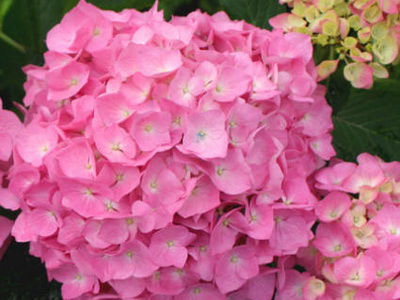
and Sauer Tharese;
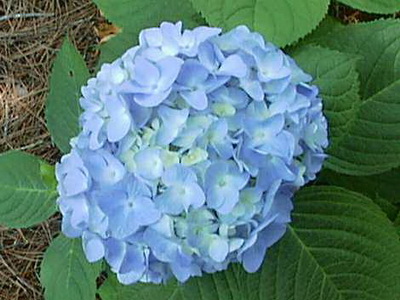
With different shades of pink or blue:

Hamburg ,

goliaph
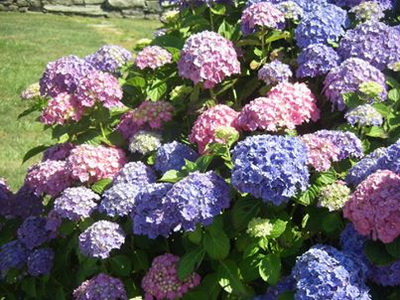
and Europa .

Prima – with red or blue flowers;
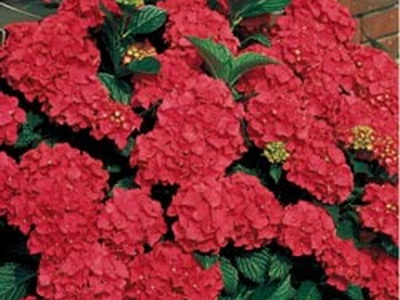
Compacta is a variety of hydrangea with white or pink inflorescences.
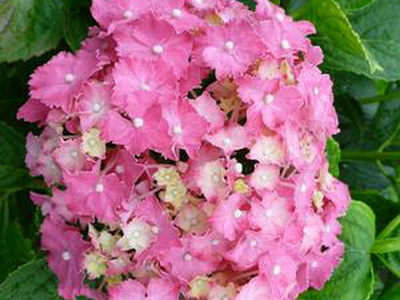
Hydrangea care at home
In the city, caring for hydrangeas at home is quite difficult to organize, but possible. You can, for example, move the plant to the basement or move it to the loggia. If the hydrangea is left without such a “rest”, it may not bloom in the spring. In addition, the plant will grow strongly over time, and the most beautiful and strong inflorescences are formed on the shoots of the first year, so indoor specimens are best rejuvenated annually, that is, grow new specimens from cuttings.
The growth and flowering period requires bright diffused lighting, regular abundant watering, high air humidity and fertilizing with complex fertilizers twice a month (plants with blue flowers need fertilizers with a low content of phosphorus and rich in potassium).
Hydrangea does not like hard tap water. Hydrangea care at home involves watering with rain, boiled or well-settled water. Indoor hydrangea is easily propagated by apical cuttings taken from young basal shoots.
The secret to changing the color of flowers from red to blue is due to the high acidity of the soil.
To “manifest” the blue spectrum of home hydrangea flowers, you can add peat to the soil or water it twice a week with a solution of potassium alum. Also, gardeners recommend simply putting an ordinary iron nail under the roots when planting.






